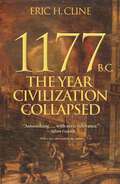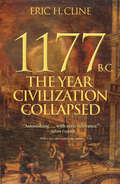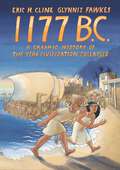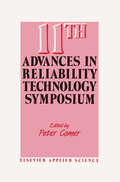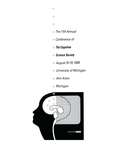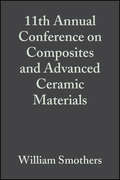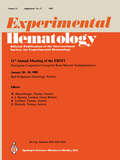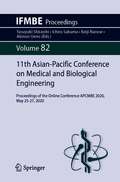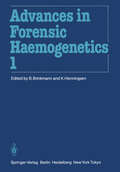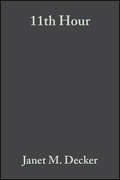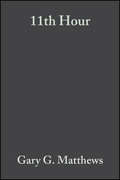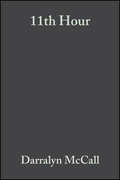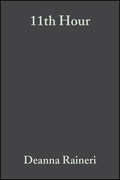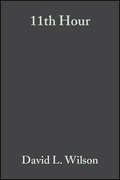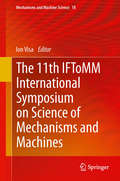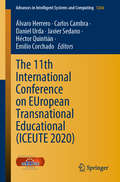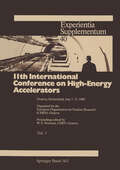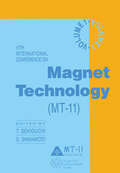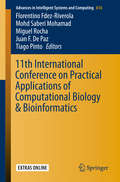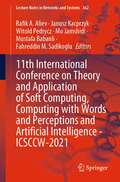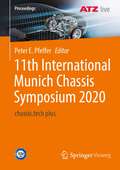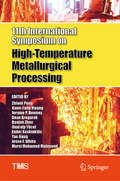- Table View
- List View
1177 B.C.: The Year Civilization Collapsed: Revised and Updated (Turning Points in Ancient History #1)
by Eric ClineA bold reassessment of what caused the Late Bronze Age collapseIn 1177 B.C., marauding groups known only as the "Sea Peoples" invaded Egypt. The pharaoh's army and navy managed to defeat them, but the victory so weakened Egypt that it soon slid into decline, as did most of the surrounding civilizations. After centuries of brilliance, the civilized world of the Bronze Age came to an abrupt and cataclysmic end. Kingdoms fell like dominoes over the course of just a few decades. No more Minoans or Mycenaeans. No more Trojans, Hittites, or Babylonians. The thriving economy and cultures of the late second millennium B.C., which had stretched from Greece to Egypt and Mesopotamia, suddenly ceased to exist, along with writing systems, technology, and monumental architecture. But the Sea Peoples alone could not have caused such widespread breakdown. How did it happen?In this major new account of the causes of this "First Dark Ages," Eric Cline tells the gripping story of how the end was brought about by multiple interconnected failures, ranging from invasion and revolt to earthquakes, drought, and the cutting of international trade routes. Bringing to life the vibrant multicultural world of these great civilizations, he draws a sweeping panorama of the empires and globalized peoples of the Late Bronze Age and shows that it was their very interdependence that hastened their dramatic collapse and ushered in a dark age that lasted centuries.A compelling combination of narrative and the latest scholarship, 1177 B.C. sheds new light on the complex ties that gave rise to, and ultimately destroyed, the flourishing civilizations of the Late Bronze Age—and that set the stage for the emergence of classical Greece.
1177 B.C.: The Year Civilization Collapsed (Turning Points in Ancient History)
by Eric H. ClineIn 1177 B.C., marauding groups known only as the "Sea Peoples" invaded Egypt. The pharaoh's army and navy managed to defeat them, but the victory so weakened Egypt that it soon slid into decline, as did most of the surrounding civilizations. After centuries of brilliance, the civilized world of the Bronze Age came to an abrupt and cataclysmic end. Kingdoms fell like dominoes over the course of just a few decades. No more Minoans or Mycenaeans. No more Trojans, Hittites, or Babylonians. The thriving economy and cultures of the late second millennium B.C., which had stretched from Greece to Egypt and Mesopotamia, suddenly ceased to exist, along with writing systems, technology, and monumental architecture. But the Sea Peoples alone could not have caused such widespread breakdown. How did it happen?In this major new account of the causes of this "First Dark Ages," Eric Cline tells the gripping story of how the end was brought about by multiple interconnected failures, ranging from invasion and revolt to earthquakes, drought, and the cutting of international trade routes. Bringing to life the vibrant multicultural world of these great civilizations, he draws a sweeping panorama of the empires and globalized peoples of the Late Bronze Age and shows that it was their very interdependence that hastened their dramatic collapse and ushered in a dark age that lasted centuries.A compelling combination of narrative and the latest scholarship, 1177 B.C. sheds new light on the complex ties that gave rise to, and ultimately destroyed, the flourishing civilizations of the Late Bronze Age—and that set the stage for the emergence of classical Greece.
1177 B.C.: The Year Civilization Collapsed (Turning Points in Ancient History)
by Eric H. ClineIn 1177 B.C., marauding groups known only as the "Sea Peoples" invaded Egypt. The pharaoh's army and navy managed to defeat them, but the victory so weakened Egypt that it soon slid into decline, as did most of the surrounding civilizations. After centuries of brilliance, the civilized world of the Bronze Age came to an abrupt and cataclysmic end. Kingdoms fell like dominoes over the course of just a few decades. No more Minoans or Mycenaeans. No more Trojans, Hittites, or Babylonians. The thriving economy and cultures of the late second millennium B.C., which had stretched from Greece to Egypt and Mesopotamia, suddenly ceased to exist, along with writing systems, technology, and monumental architecture. But the Sea Peoples alone could not have caused such widespread breakdown. How did it happen?In this major new account of the causes of this "First Dark Ages," Eric Cline tells the gripping story of how the end was brought about by multiple interconnected failures, ranging from invasion and revolt to earthquakes, drought, and the cutting of international trade routes. Bringing to life the vibrant multicultural world of these great civilizations, he draws a sweeping panorama of the empires and globalized peoples of the Late Bronze Age and shows that it was their very interdependence that hastened their dramatic collapse and ushered in a dark age that lasted centuries.A compelling combination of narrative and the latest scholarship, 1177 B.C. sheds new light on the complex ties that gave rise to, and ultimately destroyed, the flourishing civilizations of the Late Bronze Age—and that set the stage for the emergence of classical Greece.
1177 B.C.: A Graphic History of the Year Civilization Collapsed
by Eric H. Cline Glynnis FawkesA beautiful, full-color graphic version of Eric Cline&’s bestselling 1177 B.C., adapted by award-winning author-illustrator Glynnis FawkesEric Cline&’s 1177 B.C. tells the story of one of history&’s greatest mysteries: what caused the ancient civilizations of the Aegean and Eastern Mediterranean to collapse more than three thousand years ago, bringing the Late Bronze Age to an abrupt end? In this vivid and captivating full-color graphic adaptation of the landmark book, author-illustrator Glynnis Fawkes invites us to follow two young friends living in the aftermath of the cataclysm as they unravel why it happened—and reveal important lessons for today&’s interconnected and vulnerable world.Pel, a member of the marauding Sea Peoples, and Shesha, an Egyptian scribe, visit the kingdoms of the Minoans, Mycenaeans, Hittites, Canaanites, Assyrians, and Egyptians to explore the calamities that brought them down. This graphic history depicts the people, events, art, architecture, and lands that Pel and Shesha encounter. We witness the Sea Peoples&’ battles on land and sea, earthquakes on the Greek mainland, droughts and famine in Anatolia, invasions in north Syria, and possible rebellions in Canaan. Along the way, we also learn about the assassination of a Hittite prince traveling to marry an Egyptian queen, the sinking of a merchant ship laden with international goods, and the return of a pair of sandals to Crete by the Babylonian king Hammurabi.An entertaining adventure story, this dazzling comic is also historically accurate and enlightening, inviting readers of all ages to think about the surprising factors and theories that explain why societies, whether ancient or modern, die or survive when struck by catastrophes.
11th Advances in Reliability Technology Symposium
by P. ComerOn behalf of the Organising Committee of the 11th ARTS I would like to welcome all the delegates, session chairpersons and authors. I particularly welcome new delegates, delegates from mainland Europe and from other countries. At the time of the last symposium, our tenth anniversary, we looked back on the growth of the symposium and the support it had received from so many people. Not least was the support given by Mrs Ruth Campbell who, between this symposium and the last, has retired from the National Centre of Systems Reliability. The Organising Committee would hereby like to acknowledge a very special debt of gratitude, over many years, to Ruth. Our gratitude also goes to Dr A. Z. Keller of the University of Bradford, the Organising Committee Chairman at the 10th Symposium, our President for 11th ARTS and, since the beginning, a staunch supporter of the ARTS. Our thanks go to Mme A. Camino of Electricite de France for being our after-dinner speaker and to Mr A. J. Bourne for being our keynote speaker. Their speeches have been keenly anticipated. Behind the symposium, the detailed and hard work of the administrative staff of the National Centre of Systems Reliability continues even after it has ended. Our thanks go to them, particularly, and to the Universities of Liverpool, Manchester Institute of Science and Technology and Bradford for their consistent support to the symposium.
11th Annual Conference Cognitive Science Society Pod
by Cognitive Science Cognitive Science SocietyFirst published in 1989. Routledge is an imprint of Taylor & Francis, an informa company.
11th Annual Conference Cognitive Science Society Pod
by Cognitive Science Cognitive Science SocietyFirst published in 1989. Routledge is an imprint of Taylor & Francis, an informa company.
11th Annual Conference on Composites and Advanced Ceramic Materials (Ceramic Engineering and Science Proceedings #92)
by William J. SmothersThis volume is part of the Ceramic Engineering and Science Proceeding (CESP) series. This series contains a collection of papers dealing with issues in both traditional ceramics (i.e., glass, whitewares, refractories, and porcelain enamel) and advanced ceramics. Topics covered in the area of advanced ceramic include bioceramics, nanomaterials, composites, solid oxide fuel cells, mechanical properties and structural design, advanced ceramic coatings, ceramic armor, porous ceramics, and more.
11th Annual meeting of the EBMT: European Cooperative Group for Bone Marrow Transplantation (Experimental Hematology Today)
by W. Hinterberger A. J. Barrett K. Lechner E. Deutsch11th Asian-Pacific Conference on Medical and Biological Engineering: Proceedings of the Online Conference APCMBE 2020, May 25-27, 2020 (IFMBE Proceedings #82)
by Yasuyuki Shiraishi Ichiro Sakuma Keiji Naruse Akinori UenoThis book presents cutting-edge research and developments in the field of medical and biological engineering, which a special emphasis on activities carried out in the Asian-Pacific region. Gathering the proceedings of the 11th Asian-Pacific Conference on Medical and Biological Engineering, organized in Japan and held online on May 25-27, 2020, the book both fundamental research and clinical applications relating to medical instrumentations, bioimaging, bioinformatics and computational biomedicine, AI and data science in healthcare, as well as regenerative medicine and rehabilitation. It aims at informing on new trends, challenges and solutions, and fosters communication and collaboration between medical scientists, engineers, and researchers dealing with cutting-edge themes in broad field of biomedical and clinical engineering.
11th Chaotic Modeling and Simulation International Conference (Springer Proceedings in Complexity)
by Ihor Lubashevsky Christos H. SkiadasNo synopsis available.
11th Congress of the Society for Forensic Haemogenetics: Copenhagen, August 6–10, 1985 (Advances in Forensic Haemogenetics #1)
by W. Spielmann P. Engelfriet R. Bütler P. J. Lincoln11th Hour: Introduction to Immunology
by Janet M. DeckerThe 11th Hour Series of revision guides are designed for quick reference. The organization of these books actively involves studetns in the learning process and reinforces concepts. At the end of each chapter there is a test including multiple choice questions, true/false questions and short answer questions, and every answer involves an explanation. Each book contains icons in the text indicating additional support on a dedicated web page. Students having difficulties with their courses will find this an excellent way to raise their grades. Clinical correlations or everyday applications include examples from the real world to help students understand key concepts more readily. Dedicated web page, there 24 hours a day, will give extra help, tips, warnings of trouble spots, extra visuals and more. A quick check on what background students will need to apply helps equip them to conquer a topic. The most important information is highlighted and explained, showing the big picture and eliminating the guesswork. After every topic and every chapter, lots of opportunity for drill is provided in every format, multiple choice, true/false, short answer, essay. An easy trouble spot identifier demonstrates which areas need to be reinforced and where to find information on them. Practice midterms and finals prep them for the real thing.
11th Hour: Introduction to Neuroscience
by Gary G. MatthewsThe 11th Hour Series of revision guides are designed for quick reference. The organization of these books actively involves students in the learning process and reinforces concepts. At the end of each chapter there is a test including multiple choice questions, true/false questions and short answer questions, and every answer involves an explanation. Each book contains icons in the text indicating additional support on a dedicated web page. Students having difficulties with their courses will find this an excellent way to raise their grades. Clinical correlations or everyday applications include examples from the real world to help students understand key concepts more readily. Dedicated web page, there 24 hours a day, will give extra help, tips, warnings of trouble spots, extra visuals and more. A quick check on what background students will need to apply helps equip them to conquer a topic. The most important information is highlighted and explained, showing the big picture and eliminating the guesswork. After every topic and every chapter, lots of opportunity for drill is provided in every format, multiple choice, true/false, short answer, essay. An easy trouble spot identifier demonstrates which areas need to be reinforced and where to find information on them. Practice midterms and finals prep them for the real thing.
11th Hour: Introduction to Microbiology
by Darralyn McCall David Stock Phillip AcheyThe 11th Hour Series of revision guides have been designed for quick reference. The organisation of these books will involve students actively in the learning process and reinforcement of concepts. At the end of each chapter there will be a test including multiple choice questions, true/false questions and short answer questions, every answer will involve an explanation. Each book will contain icons in the text indicating additional support on a dedicated web-page. Students having difficulties with their courses will find this an excellent way to raise their grades. Clinical correlations or everyday applications include examples from the real world to help students understand key concepts more readily. Dedicated web page, there 24 hours a day, will give extra help, tips, warnings of trouble spots, extra visuals and more. A quick check on what background students will need to apply helps equip them to conquer a topic. The most important information is highlighted and explained, showing the big picture and eliminating the guesswork. After every topic and every chapter, lots of opportunity for drill is provided in every format, multiple choice, true/false, short answer, essay. An easy trouble spot identifier demonstrates which areas need to be reinforced and where to find information on them. Practice midterms and finals prep them for the real thing.
11th Hour: Introduction to Molecular Biology
by Deanna RaineriThe 11th Hour Series is designed to be used when a textbook doesn''t make sense, when the course content is tough, or when you just want a better grade in the course. The authors cut through the fluff, get to what you need to know, and then help you understand it. Clinical correlations or everyday applications include examples from the real world to help students understand key concepts more readily. Dedicated web page, there 24 hours a day, will give extra help, tips, warnings of trouble spots, extra visuals and more. A quick check on what background students will need to apply helps equip them to conquer a topic. The most important information is highlighted and explained, showing the big picture and eliminating the guesswork. After every topic and every chapter, lots of opportunity for drill is provided in every format, multiple choice, true/false, short answer, essay. An easy trouble spot identifier demonstrates which areas need to be reinforced and where to find information on them. Practice midterms and finals prep them for the real thing.
11th Hour: Introduction to Biology
by David L. WilsonVisit www.blackwellpublishing.com/11thhour for additional information. This book reviews the more challenging material in a college-level, introductory course in biology. It is intended to supplement standard textbooks in biology, or for students who wish to review such material. '11th Hour: Introduction to Biology' is of particular use to students enrolled in a majors or non-majors introductory biology course, or students taking AP biology. It concentrates on those topics that usually give students the most difficulty, and problems/questions are rated throughout in terms of their level of difficulty. Concentrates on those concepts that usually give students the most difficulty. Provides ample opportunity to test the mastery of this material. Rates questions/problems according to their level of difficulty. Additional information provided on the internet site related to this topic - www.blackwellpublishing.com/11thhour.
The 11th IFToMM International Symposium on Science of Mechanisms and Machines (Mechanisms and Machine Science #18)
by Ion VisaThe general topic of the symposium follows mechanisms development through all stages of conception, modeling, analysis, synthesis and control to advanced product design. This volume brings together the latest results in the field and celebrates a series of conferences that has been running for 40 years. The contributors and the editor are world leaders in their field.
The 11th International Conference on EUropean Transnational Educational (Advances in Intelligent Systems and Computing #1266)
by Álvaro Herrero Carlos Cambra Daniel Urda Javier Sedano Héctor Quintián Emilio CorchadoThis book contains accepted papers presented at ICEUTE 2020 held in the beautiful and historic city of Burgos (Spain), in September 2020.The 11th International Conference on EUropean Transnational Education (ICEUTE 2020) has been a meeting point for people working on transnational education within Europe. It has provided a stimulating and fruitful forum for presenting and discussing the latest works and advances on transnational education within European countries.After a thorough peer-review process, the ICEUTE 2020 International Program Committee selected 44 papers which are published in these conference proceedings achieving an acceptance rate of 41%. Due to the COVID-19 outbreak, the ICEUTE 2020 edition was blended, combining on-site and on-line participation. In this relevant edition, a special emphasis was put on the organization of five special sessions related to relevant topics as Role of English in Transnational Education and Teacher Training, Personalization and ICT: a Path to Educational Inclusion, Innovation and Research Findings in Engineering Higher Education, Practical Implementations of Novel Initiatives, and Innovation in Computer Science Higher Education.The selection of papers was extremely rigorous in order to maintain the high quality of the conference, and we would like to thank the members of the Program Committees for their hard work in the reviewing process. This is a crucial process to the creation of a high standard conference, and the ICEUTE conference would not exist without their help.
11th International Conference on High-Energy Accelerators: Geneva, Switzerland, July 7–11, 1980 (Experientia Supplementum #40)
by NewmanThe Conference timetable had to be so arranged as to spread the main topics over several separate sessions. It was therefore decided to publish the material in these Proceedings under nine subject headings, irrespective of session. Within each chapter, which is preceded by a list of the sessions featuring the subject, all papers, invited and contributed, whether presented at the Conference or accepted for publication only, have been arranged in some lo gical order. The reports of the four Panel Discussions were edited or summarized by the respective Moderator in consultation with Panel Members. In one instance, shortened versions of the Introductory Papers precede the discussion. Where possible, verbatim accounts of the often lively exchanges have been retained. The customary catalogue of high-energy acceler ators has been published separately. The continuing world-wide activities in accelerator research, witl1 its ever larger pro jects, are reflected by the numerous contributions accepted for inclusion in these Proceedings, which have reached the limit of what a single volume can manageably contain, while making rapid publication even harder to achieve. All the more reason to extend the gratitude of all con cerned to those involved in the chain of production: - To the authors, for their prompt handing-in or timely posting of their papers. Thanks also to their secretaries who followed the guidelines for the presentation of camera-ready copy.
11th International Conference on Magnet Technology (MT-11): Volume 1
by T. Sekiguchi S. ShimamotoOver the years the aim of the International Conference on Magnet Technology has been the exchange of information on the design, construction and operation of magnets for a variety of applications, such as high energy physics, fusion, electrical machinery and others. The aim has included advances in materials for magnet conductors, insulators and supporting structures. Since its inception the focus of the International Conference on Magnet Technology has gradually shifted to superconducting magnets. Now almost all papers are related to superconductivity. The 11th International Conference on Magnet Technology (MT-11) was organized by the combined efforts of the Institute of Electrical Engineers of Japan, the Association for Promotion of Electrical, Electronic and Information Engineering, and the Tokyo Section of the IEEE. The Conference was held at the Tsukuba University Hall, Tsukuba, Japan, from 28 August to 1 September 1989, courtesy ofthe University ofTsukuba. The Tsukuba University Hall was large enough to host invited talks, parallel sessions, poster sessions and industrial exhibitions. 461 participants from 19 countries registered for MT-ll, and 280 invited and contributed papers were presented. The papers were reviewed not only by the Program Committee but also by foreign participants. Working sessions and social events were characterized by a truly international atmo sphere. Scientific as well as cultural excursions were organized so that foreign visitors could experience the spirit of modern Japan. 26 companies, of which 8 were from Western countries, participated in the industrial exhibition which featured diverse products and services of interest to the magnet community.
11th International Conference on Practical Applications of Computational Biology & Bioinformatics (Advances in Intelligent Systems and Computing #616)
by Florentino Fdez-Riverola Mohd Saberi Mohamad Miguel Rocha Juan F. De Paz Tiago PintoBiological and biomedical research are increasingly driven by experimental techniques that challenge our ability to analyse, process and extract meaningful knowledge from the underlying data. The impressive capabilities of next-generation sequencing technologies, together with novel and constantly evolving, distinct types of omics data technologies, have created an increasingly complex set of challenges for the growing fields of Bioinformatics and Computational Biology. The analysis of the datasets produced and their integration call for new algorithms and approaches from fields such as Databases, Statistics, Data Mining, Machine Learning, Optimization, Computer Science and Artificial Intelligence. Clearly, Biology is more and more a science of information and requires tools from the computational sciences. In the last few years, we have seen the rise of a new generation of interdisciplinary scientists with a strong background in the biological and computational sciences. In this context, the interaction of researchers from different scientific fields is, more than ever, of foremost importance in boosting the research efforts in the field and contributing to the education of a new generation of Bioinformatics scientists. The PACBB’17 conference was intended to contribute to this effort and promote this fruitful interaction, with a technical program that included 39 papers spanning many different sub-fields in Bioinformatics and Computational Biology. Further, the conference promoted the interaction of scientists from diverse research groups and with a distinct background (computer scientists, mathematicians, biologists).
11th International Conference on Theory and Application of Soft Computing, Computing with Words and Perceptions and Artificial Intelligence - ICSCCW-2021 (Lecture Notes in Networks and Systems #362)
by Witold Pedrycz Janusz Kacprzyk Mo Jamshidi Rafik A. Aliev Fahreddin M. Sadikoglu Mustafa BabanliThis book presents the proceedings of the 11th Conference on Theory and Applications of Soft Computing, Computing with Words and Perceptions and Artificial Intelligence, ICSCCW-2021, held in Antalya, Turkey, on August 23–24, 2021. The general scope of the book covers uncertain computation, decision making under imperfect information, neuro-fuzzy approaches, natural language processing, and other areas. The topics of the papers include theory and application of soft computing, computing with words, image processing with soft computing, intelligent control, machine learning, fuzzy logic in data mining, soft computing in business, economics, engineering, material sciences, biomedical engineering, and health care. This book is a useful guide for academics, practitioners, and graduates in fields of soft computing and computing with words. It allows for increasing of interest in development and applying of these paradigms in various real-life fields.
11th International Munich Chassis Symposium 2020: chassis.tech plus (Proceedings)
The increasing automation of driving functions and the electrification of powertrains present new challenges for the chassis with regard to complexity, redundancy, data security,and installation space. At the same time, the mobility of the future will also require entirely new vehicle concepts, particularly in urban areas. The intelligent chassis must be connected, electrified, and automated in order to be best prepared for this future.ContentsNew Chassis Systems.- Handling and Vehicle Dynamics.- NVH – Acoustics and Vibration in the Chassis.- Smart Chassis, ADAS, and Autonomous Driving.- Lightweight Design.- Innovative Brake Systems.- Brakes and the Environment.- Electronic Chassis Systems.- Virtual Chassis Development and Homologation.- Innovative Steering Systems and Steer-by-Wire.- Development Process, System Properties and Architecture.- Innovations in Tires and Wheels.Target audiencesAutomotive engineers and chassis specialists as well as students looking for state-of-the-art information regarding their field of activity - Lecturers and instructors at universities and universities of applied sciences with the main subject of automotive engineering - Experts, researchers and development engineers of the automotive and the supplying industryPublisherATZ live stands for top quality and a high level of specialist information and is part of Springer Nature, one of the leading publishing groups worldwide for scientific, educational and specialist literature.PartnerTÜV SÜD is an international leading technical service organisation catering to the industry, mobility and certification segment.
11th International Symposium on High-Temperature Metallurgical Processing (The Minerals, Metals & Materials Series)
by Zhiwei Peng Jiann-Yang Hwang Jerome P. Downey Dean Gregurek Baojun Zhao Onuralp Yücel Ender Keskinkilic Tao Jiang Jesse F. White Morsi Mohamed MahmoudIn recent years, global metallurgical industries have experienced fast and prosperous growth. High-temperature metallurgical technology is the backbone to support the technical, environmental, and economical needs for this growth. This collection features contributions covering the advancements and developments of new high-temperature metallurgical technologies and their applications to the areas of processing of minerals; extraction of metals; preparation of refractory and ceramic materials; sintering and synthesis of fine particles; treatment and recycling of slag and wastes; and saving of energy and protection of environment. The volume will have a broad impact on the academics and professionals serving the metallurgical industries around the world.
